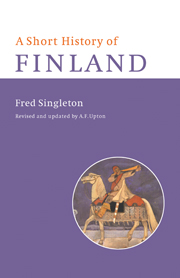Book contents
- Frontmatter
- Contents
- List of maps
- Dedication
- Preface
- 1 HISTORY OF FINLAND
- 2 FINLAND AND SWEDEN
- 3 FINLAND, SWEDEN AND RUSSIA IN THE EIGHTEENTH CENTURY
- 4 THE FINNISH NATIONAL AWAKENING
- 5 THE FINNISH ECONOMY IN THE NINETEENTH CENTURY
- 6 THE POLITICAL DEVELOPMENT OF FINLAND, 1863–I917
- 7 INDEPENDENT FINLAND
- 8 FINLAND IN THE SECOND WORLD WAR
- 9 FINLAND IN THE POST-WAR WORLD: THE POLITICAL SITUATION
- 10 THE ECONOMY OF FINLAND IN THE TWENTIETH CENTURY
- 11 THE SPIRIT OF FINLAND
- Appendices
- Bibliography by John J. Horton
- Index
7 - INDEPENDENT FINLAND
Published online by Cambridge University Press: 28 January 2010
- Frontmatter
- Contents
- List of maps
- Dedication
- Preface
- 1 HISTORY OF FINLAND
- 2 FINLAND AND SWEDEN
- 3 FINLAND, SWEDEN AND RUSSIA IN THE EIGHTEENTH CENTURY
- 4 THE FINNISH NATIONAL AWAKENING
- 5 THE FINNISH ECONOMY IN THE NINETEENTH CENTURY
- 6 THE POLITICAL DEVELOPMENT OF FINLAND, 1863–I917
- 7 INDEPENDENT FINLAND
- 8 FINLAND IN THE SECOND WORLD WAR
- 9 FINLAND IN THE POST-WAR WORLD: THE POLITICAL SITUATION
- 10 THE ECONOMY OF FINLAND IN THE TWENTIETH CENTURY
- 11 THE SPIRIT OF FINLAND
- Appendices
- Bibliography by John J. Horton
- Index
Summary
The declaration of independence was accepted by Lenin, who met Svinhufvud in Petrograd 31 December 1917 and told him that the Bolsheviks would recognize the right-wing government in Helsinki. Sweden, Denmark, Norway, France, Germany and Austria-Hungary soon followed, but Britain and the United States waited until 1920 before they accepted Finnish independence de jure, although de facto recognition was accorded by Britain in 1918.
One of the factors which delayed full British recognition was the equivocal relationship of the new Finnish government to Germany. Another was the continued presence of 40,000 Russian troops on Finnish soil. There was a link between these two items. The Bolsheviks feared that Finland might be used by Germany as a springboard for an attack on Petrograd, and justified their failure to evacuate their troops and the naval garrison at Helsinki on these grounds.
In January 1918 the civil war which had been looming for several months finally broke out. Both sides had been preparing for it for some time. The Svinhufvud government requested the Germans on 19 January to return the Jäger battalion and all its equipment to Finland as soon as possible. On 24 January the government demanded the removal of Russian troops and requested help from those countries which had recognized Finland's independence – which included Germany.
- Type
- Chapter
- Information
- A Short History of Finland , pp. 108 - 121Publisher: Cambridge University PressPrint publication year: 1998



